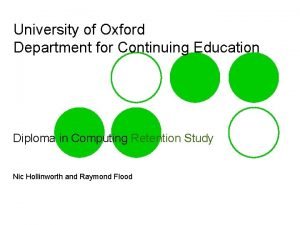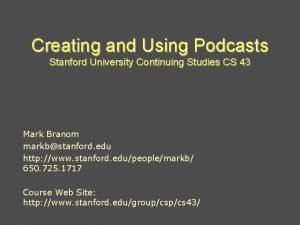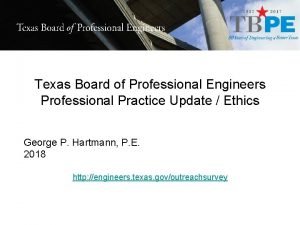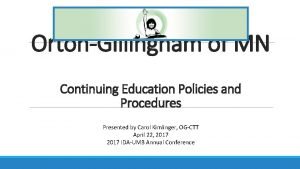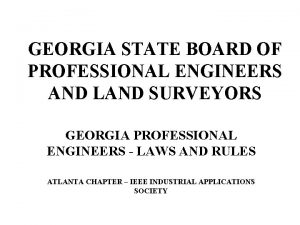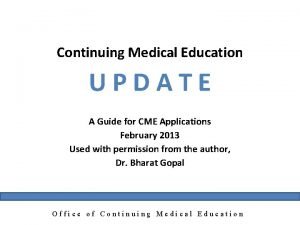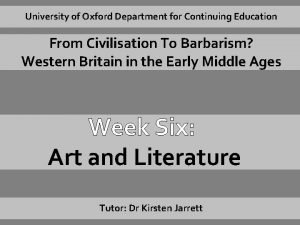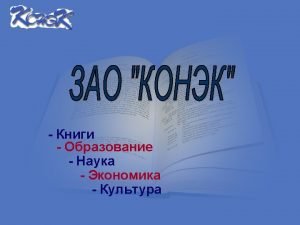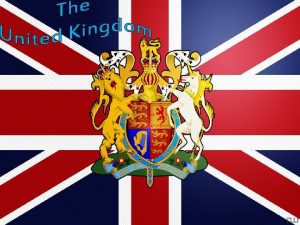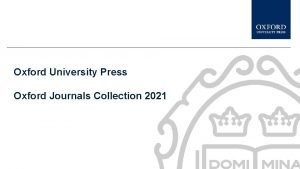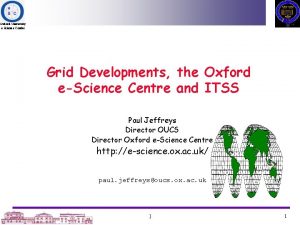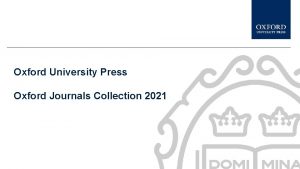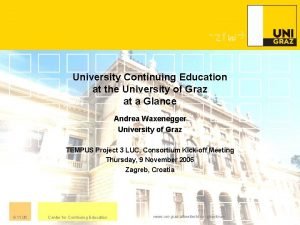University of Oxford Department for Continuing Education From




![De Excidio Britanniae (‘D. E. B. ’) 3: 2. [Britain] is ornamented with twentyeight De Excidio Britanniae (‘D. E. B. ’) 3: 2. [Britain] is ornamented with twentyeight](https://slidetodoc.com/presentation_image/4dadacd46d65c1a2a37d20cb68d06ae8/image-5.jpg)











- Slides: 16

University of Oxford Department for Continuing Education From Civilisation To Barbarism? Western Britain in the Early Middle Ages Week Two: Urban Settlement Tutor: Dr Kirsten Jarrett

Student Information Continuing Education Library Rewley House, Wellington Square, Oxford, OX 1 2 HY http: //www. conted. ox. ac. uk/facilities/library/ Opening hours Term-time (to 14 th Dec. ): Vacation (to 7 th Jan. ): Mon–Thurs: 9 am - 8. 30 pm Mon – Fri: 9 am - 5 pm Fri: 9 am - 5 pm Sat & Sun: Closed Sat: 9. 30 am - 5. 30 pm Closed 22 nd Dec. -1 st Jan. Sun: 1 pm - 4 pm Necessary for Homework & Assignments!

Assignments Option A: • To enable feedback between each assignment: to tutor ASAP • Complete portfolio (four answers, each x 250 words): Preferably to tutor by 27 th Nov. Final deadline: 4 th Jan. (submissions after final class - to OUDCE) Option B: • Essay plan to tutor before final class • Final deadline: 4 th Jan. (submissions after final class - to OUDCE)

Part One • Group discussion: Home-study review and key questions • Written evidence and place names: settlement • Urban decline and change: dark earth & decay • Group exercise: placing place names (depending on time taken on group discussion: if short of time, undertake as homework) [Handout: p. 8, Worksheet 2 A p. 9]
![De Excidio Britanniae D E B 3 2 Britain is ornamented with twentyeight De Excidio Britanniae (‘D. E. B. ’) 3: 2. [Britain] is ornamented with twentyeight](https://slidetodoc.com/presentation_image/4dadacd46d65c1a2a37d20cb68d06ae8/image-5.jpg)
De Excidio Britanniae (‘D. E. B. ’) 3: 2. [Britain] is ornamented with twentyeight cities…. 24: 3. All the major towns were laid low by the repeated battering of enemy rams… 26: 2. But the cities of our land are not populated even now as they once were; right to the present day they are deserted, in ruins and unkempt.

Towns of later Roman Western Britain

‘Nennius’s’ ‘Ancient Cities’ Cair gurcoc (Anglesey? ) Cair custeint (Caernarfon) Cair guoranegon (Worcester) Cair merdin (Carmarthen) Cair lion (Caerleon-upon-Usk) Cair ceri (Cirencester) Cair gloui (Gloucester) Cair britoc (Bristol) Cair ligion (Chester? ) Cair guent (Caerwent) Cair guorcon (Warren, Pemb. ? ) Cairteimm (Teigngrace, Devon) Cair urnahc (Wroxeter) Cair colemion (? ‘Camelet’) Cair meguaid (Meifod, Powys) Cair guorthegern (Salisbury? ) Cair daun = dauri (Dorchester? )

Urban Transformation: ‘Decline’ or change? General late 4 th century trends in major towns: • Changing use / contraction of public buildings • Increased wealth of private buildings and encroachment onto roads • Increased industrial activity • Enhanced defences and control of movement Small Towns: Late C 4: Commercial and industrial centres - Few indicators of continuity

Late 4 th – 7 th Century Transformation of Urban Centres • • • Contraction of town walls Possible intra-mural agriculture Demolition of public buildings Construction in timber Intra-mural burial and / or construction of ecclesiastical buildings in some towns

Place names Creech = cruc Tre = Farmstead Avon = River Pen = Headland Coyd = wood Caer = walled settlement Walh = ‘foreigner’ Chester = (Roman) Walled town Wic = settlement Ham = homestead (Handout 2 A, p. 7, & Worksheet 2 A, p. 8)

Part Two • Regional case studies • Session review / Home-study guidance [Week 2: Session review sheet] • Group exercise: analysing urban settlements, (depending on time taken on group discussion: if short of time, undertake as homework) [Worksheet 2 B: p. 910]

Wroxeter basilica

New Market Hall site: • Ash & molten lead = metalworking • Spearhead & human jaw on mosaic • Hoard including early C 5 coin • Late Roman ‘military ‘buckle, bracelet & penannular brooch • Continued use of some later Roman ceramics • ‘Dark earth’ Tilery: • Post-holes = timber building • Dark earth • Continued presence of some later Roman ceramics • Early C 5 coin • ‘Grass-tempered’ pottery Castle Site: • Building continued use C 5+ (TPQ = 374 C 14: TAQ =C 6) St Oswalds • Post-holes cut into floor Tilery • Build up of loam • >EC 5 Hearths, lead ingot, & Castle charcoal = metalworking • C 5 pottery • Human / animal bone Gloucester >LC 4 <C 6

Caerwent


Group Exercise: Urban Settlements
 Oxford continuing education
Oxford continuing education Oxford dept of continuing education
Oxford dept of continuing education Stanford continuing studies certificate
Stanford continuing studies certificate San diego continuing education north city campus
San diego continuing education north city campus Texas professional engineer continuing education
Texas professional engineer continuing education Imslec
Imslec Kylene perras uconn
Kylene perras uconn Ct p1 continuing education
Ct p1 continuing education Tesol course uq
Tesol course uq Nj institute for continuing legal education
Nj institute for continuing legal education Georgia professional engineer
Georgia professional engineer Life long education artinya
Life long education artinya Dlgf(dlgf)continuing education/webinars
Dlgf(dlgf)continuing education/webinars Pace chiropractic continuing education
Pace chiropractic continuing education Bladen community college online classes
Bladen community college online classes Continuing medical education
Continuing medical education Aafp metric
Aafp metric
